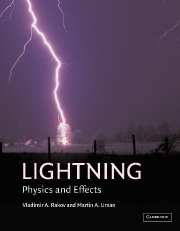Book contents
- Frontmatter
- Contents
- Preface
- 1 Introduction
- 2 Incidence of lightning
- 3 Electrical structure of lightning-producing clouds
- 4 Downward negative lightning discharges to ground
- 5 Positive and bipolar lightning discharges to ground
- 6 Upward lightning initiated by ground-based objects
- 7 Artificial initiation (triggering) of lightning by ground-based activity
- 8 Winter lightning in Japan
- 9 Cloud discharges
- 10 Lightning and airborne vehicles
- 11 Thunder
- 12 Modeling of lightning processes
- 13 The distant lightning electromagnetic environment: atmospherics, Schumann resonances, and whistlers
- 14 Lightning effects in the middle and upper atmosphere
- 15 Lightning effects on the chemistry of the atmosphere
- 16 Extraterrestrial lightning
- 17 Lightning locating systems
- 18 Deleterious effects of lightning and protective techniques
- 19 Lightning hazards to humans and animals
- 20 Ball lightning, bead lightning, and other unusual discharges
- Appendix: Books on lightning and related subjects
- Index
13 - The distant lightning electromagnetic environment: atmospherics, Schumann resonances, and whistlers
Published online by Cambridge University Press: 05 June 2013
- Frontmatter
- Contents
- Preface
- 1 Introduction
- 2 Incidence of lightning
- 3 Electrical structure of lightning-producing clouds
- 4 Downward negative lightning discharges to ground
- 5 Positive and bipolar lightning discharges to ground
- 6 Upward lightning initiated by ground-based objects
- 7 Artificial initiation (triggering) of lightning by ground-based activity
- 8 Winter lightning in Japan
- 9 Cloud discharges
- 10 Lightning and airborne vehicles
- 11 Thunder
- 12 Modeling of lightning processes
- 13 The distant lightning electromagnetic environment: atmospherics, Schumann resonances, and whistlers
- 14 Lightning effects in the middle and upper atmosphere
- 15 Lightning effects on the chemistry of the atmosphere
- 16 Extraterrestrial lightning
- 17 Lightning locating systems
- 18 Deleterious effects of lightning and protective techniques
- 19 Lightning hazards to humans and animals
- 20 Ball lightning, bead lightning, and other unusual discharges
- Appendix: Books on lightning and related subjects
- Index
Summary
… taking into consideration the large number of lightning strokes simultaneously in existence around the globe and the fact that over much of their frequency spectrum [their] fields will be trapped within the Earth–ionosphere waveguide, there will be a continuous mean noise or “atmospheric noise”.
J. Hamelin (1993)Introduction
In Chapters 4, 5, 7, and 9, we examined the electric and magnetic fields associated with lightning at distances less than a few hundred kilometers. At these ranges, the fields propagate from the lightning source to the observation point either (i) in the atmosphere along the finitely conducting Earth boundary by way of a ground wave or (ii) directly through the atmosphere by line-of-sight propagation. The features of the field waveforms from relatively close lightning are determined primarily by the characteristics of the lightning. A discussion of the effects of the conductivity and permittivity of the Earth in changing the characteristics of the ground wave was given in the last part of subsection 4.6.4. In the present chapter we examine the characteristics of the electric and magnetic fields of distant lightning, observed at ranges from a few hundred kilometers to tens of thousands of kilometers. At such distances the field waveforms are significantly influenced by the properties of the propagation path.
We will subdivide our discussion of distant electromagnetic environment into three parts, depending on the main types of observed signals: (i) atmospherics, time-domain signals typically in the VLF (3 kHz to 30 kHz) frequency band, which propagate in waveguide modes in the spherical Earth–ionosphere cavity (Section 13.3); (ii) Schumann resonances,
- Type
- Chapter
- Information
- LightningPhysics and Effects, pp. 432 - 479Publisher: Cambridge University PressPrint publication year: 2003



